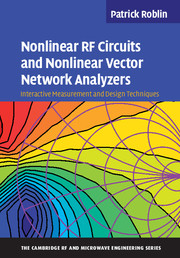 Nonlinear RF Circuits and Nonlinear Vector Network Analyzers
Nonlinear RF Circuits and Nonlinear Vector Network Analyzers Book contents
- Frontmatter
- Contents
- Preface
- Dedication
- Acknowledgments
- 1 Wireless signals
- 2 Large-signal vector measurement techniques with NVNAs
- 3 Device modeling and verification with NVNA measurements
- 4 Characterization and modeling of memory effects in RF power transistors
- 5 Interactive loadline-based design of RF power amplifiers
- 6 Behavioral modeling
- 7 Kurokawa theory of oscillator design and phase-noise theory
- 8 Design, modeling, and linearization of mixers, modulators, and demodulators
- 9 Linearization of RF power amplifiers with memory
- Index
- References
6 - Behavioral modeling
Published online by Cambridge University Press: 05 July 2011
- Frontmatter
- Contents
- Preface
- Dedication
- Acknowledgments
- 1 Wireless signals
- 2 Large-signal vector measurement techniques with NVNAs
- 3 Device modeling and verification with NVNA measurements
- 4 Characterization and modeling of memory effects in RF power transistors
- 5 Interactive loadline-based design of RF power amplifiers
- 6 Behavioral modeling
- 7 Kurokawa theory of oscillator design and phase-noise theory
- 8 Design, modeling, and linearization of mixers, modulators, and demodulators
- 9 Linearization of RF power amplifiers with memory
- Index
- References
Summary
Behavioral model for SISO and MIMO systems
In this chapter we will discuss various new techniques for the behavioral modeling of devices characterized by NVNA and VSA measurements. The reader is referred to the companion series book [1] for a comprehensive review of the field of behavioral modeling.
In our presentation we will focus on the development of single-input single-output (SISO) models. As shown in Figure 6.1(a) SISO models can be directly applied to single-port (two terminals) nonlinear loads or diodes. An example is the nonlinear negative resistance of an oscillator, which will be discussed in Chapter 7.
For the modeling of power amplifiers that are two-port devices (four terminals) a SISO model as shown in Figure 6.1(a) can be applied if we assume that the input and output ports are matched. That way, none of the reflected waves at the input b1(pω) from the device is converted into incident waves a1(pω) at port 1 and similarly none of the transmitted waves b2(pω) is converted into incident waves a2(pω) at port 2. A SISO model can also be applied to three-port modulator systems under similar approximations, as we shall see in Chapter 8.
The matching of the generator impedance and output load impedance to the characteristic impedance (typically 50 Ω) can be improved in practical systems by inserting attenuators or isolators at the input and output ports. Obviously, in the real world no device is perfect and some small reflections will still take place.
- Type
- Chapter
- Information
- Nonlinear RF Circuits and Nonlinear Vector Network AnalyzersInteractive Measurement and Design Techniques, pp. 160 - 200Publisher: Cambridge University PressPrint publication year: 2011
References
- 1
- Cited by


